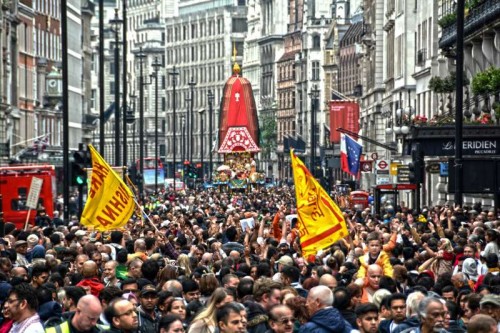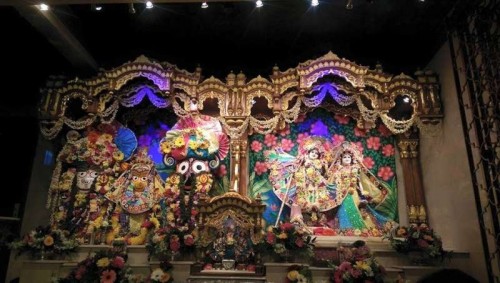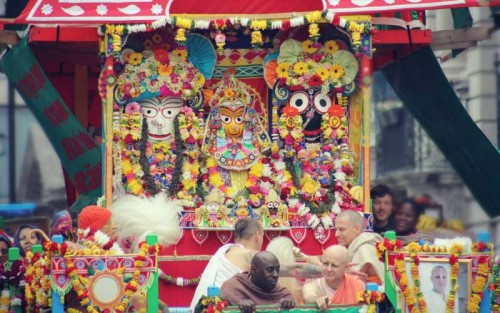Ratha-yatra, or the Festival of Chariots, is a joyous event celebrated for thousands of years in the Indian holy city of Jagannatha Puri, and in cities around the world commenced in London recently …reports Asian Lite, leading newspaper among British Asians.
 Due to unforeseen circumstances Their Lordships travelled on one cart together this year in London. Just like the old days, all devotees gathered in front of one chariot and walked from Hyde Park to Trafalgar Square.
Due to unforeseen circumstances Their Lordships travelled on one cart together this year in London. Just like the old days, all devotees gathered in front of one chariot and walked from Hyde Park to Trafalgar Square.
The Rathayatra celebrations will be held in Birmingham on Sunday 26 July; Cardiff to host on Saturday 1 August; Leicester on Sunday 2 August; Dublin and Reading have to be announced; Brighton will celebrate on Sunday 13th September; Plymouth will have it on Saturday 3 October and Glastonbury to host on Sunday 4 October.
 As the story goes, another name for Krishna, Jagannatha refers to the ecstatic form of the Lord with large eyes and rugged features who is carried on a gigantic chariot during this festival (and worshiped in an ancient temple at the center of Jagannath Puri.)
As the story goes, another name for Krishna, Jagannatha refers to the ecstatic form of the Lord with large eyes and rugged features who is carried on a gigantic chariot during this festival (and worshiped in an ancient temple at the center of Jagannath Puri.)
Furthermore the story says Lord Krishna once overheard a conversation about how His dearest devotees, the cowherd maidens of Vrindavana, were lamenting in His absence. When He heard these accounts of overwhelming love in separation, the Lord’s hair began to stand on end, His eyes opened wide and filled with tears, and His arms and legs contracted as He went into a state of spiritual ecstasy. Seeing Lord Krishna in this condition, His elder brother, Balarama (Baladeva), also began to feel ecstatic symptoms and displayed similar features. When Their sister, Subhadra, arrived at the scene, she too became consumed with ecstatic joy. Thus the sublime deity forms of Jagannatha, Subhadra, and Baladeva represent this sweet pastime.
 The festival of Ratha-yatra represents Lord Jagannatha’s longing to reunite with His dear devotees in Vrindavana, foremost among them, Srimati Radharani. According to tradition, the Lord gets lovesick once a year just prior to the festival. To cheer him up, His servants arrange for Him to go on a lavish procession to meet up with His devotees. Lord Jagannatha rides on a grand, three-story-high chariot, accompanied by thousands of onlookers and marching bands with scores of drummers, singers, and dancers. India’s colonial British rulers coined the term “juggernaut” from the large, heavy chariot used to celebrate this festival in the city of Jagannatha Puri.
The festival of Ratha-yatra represents Lord Jagannatha’s longing to reunite with His dear devotees in Vrindavana, foremost among them, Srimati Radharani. According to tradition, the Lord gets lovesick once a year just prior to the festival. To cheer him up, His servants arrange for Him to go on a lavish procession to meet up with His devotees. Lord Jagannatha rides on a grand, three-story-high chariot, accompanied by thousands of onlookers and marching bands with scores of drummers, singers, and dancers. India’s colonial British rulers coined the term “juggernaut” from the large, heavy chariot used to celebrate this festival in the city of Jagannatha Puri.
Ratha-yatra signifies the Lord’s love for His devotees. He personally comes to visit His devotees and the public who welcome Him in the streets.